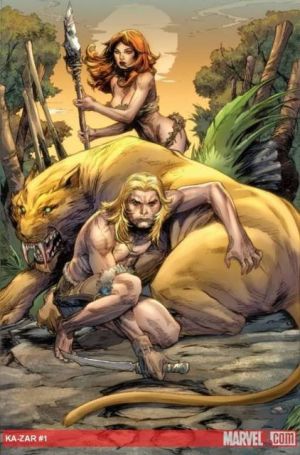|
|
 |
This opening salvo reestablishes the Pangean lost world of the Savage Land in a fantastic narrative. Once that narrative fades, however, it quickly becomes obvious that the Savage Land is under duress once again from outside influences. A conspiracy surrounding trade routes opened to Pangea is mounting, and natives of the Savage Land are dying, ecosystems are being destroyed, because of it. Before the first tribal council in seven-hundred years, Ka-Zar is approached by an outsider, a harbinger of the doom that is about to swallow the Savage Land under the guise of humanitarianism.
Jenkins puts forth a good effort at relevance here, but misses the mark somewhat. I can foresee going through my Ka-Zar collection (yes, I collect Ka-Zar comics) one day far from now and saying, "Oh, yeah. This was that miniseries that was kind of a boring, baldfaced allegory of globalization, exploitation of third-world countries, and the ecological ramifications of deforestation and offshore drilling." In a way, I'm glad to see a comic book writer stepping up and addressing these problems again. They aren't problems that have simply faded with time, but have instead worsened. It's never a bad thing to have someone present these issues to a discerning audience, but in this case it's a little dry, unfortunately.
We get more rhetoric here than entertainment, more preaching than storytelling. The true magic of a successful metaphor is hardly realizing it's there and letting it unfold in your subconscious. Jenkins' Ka-Zar sort of unabashedly bludgeons you with its unavoidable ideals and squeezes in a true plot where ever it finds room to spare. Characters are barely two-dimensional, let alone developed into actual personalities, as a result.
Pascal Alixe's artwork is gorgeous, though not as innovative as his work on Electric Ant. Aburto and Maese's color work is a little too congruous, blending into a monochrome brown sludge at many points.
I suppose only time will tell if Jenkins pulls Ka-Zar from this issue's doldrums, but I'd like to think that this story will turn out to be more than just an unsubtle bombast on modern socioeconomic evils.
© Copyright 2002-2019 by Toon Doctor Inc. - All rights Reserved. All other texts, images, characters and trademarks are copyright their respective owners. Use of material in this document (including reproduction, modification, distribution, electronic transmission or republication) without prior written permission is strictly prohibited.

